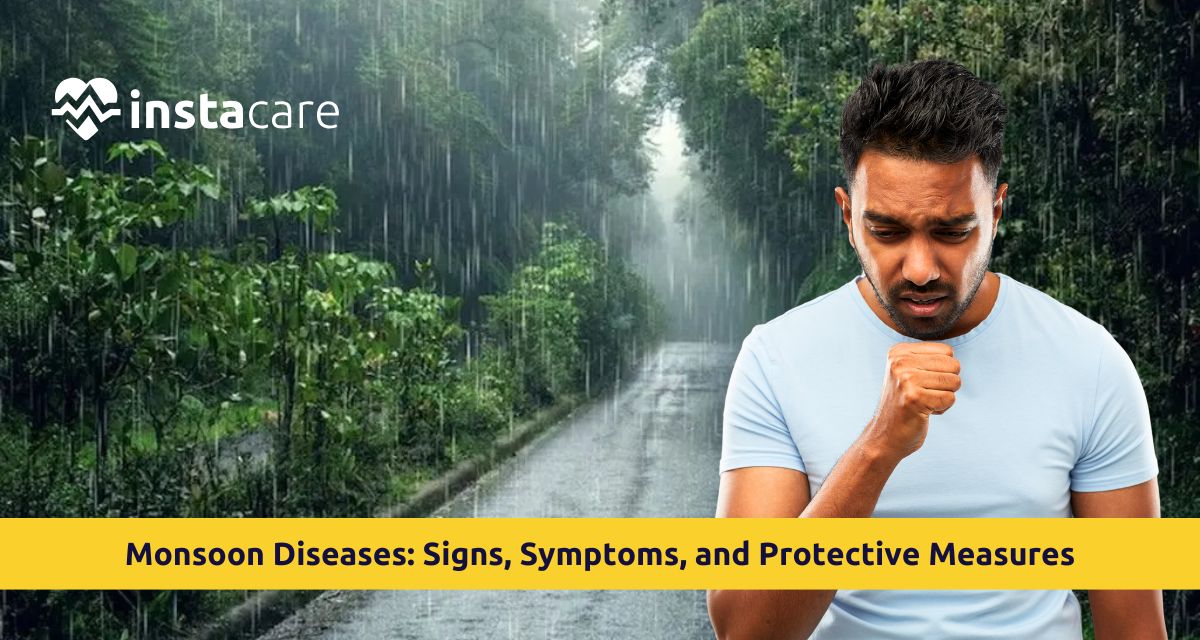You should know the dangers and hazards of diseases caused in rainy season and how to stay healthy and safe. It introduces you to the most common monsoon diseases, their signs and symptoms, and what precautions you can take to keep you on your toes and your house safe.
Common Monsoon Diseases
Monsoon disseminates a range of diseases mainly through water modes with soil, unclean environments, and vector-borne. The most prevalent among them are:
Dengue
Dengue during monsoon is an arthropod-borne viral infection. It flourishes in stagnant water where monsoons flood a large amount of water. Its signs and symptoms are high temperature, severe
headache, eyeache, joint pain, rashes, and gum bleeding. These are classic monsoon fever symptoms and should not be ignored.
Malaria
Malaria in rainy season, like dengue, is transmitted by the mosquito, that is, by the Anopheles mosquito. It breeds from the stagnating water that accumulate and settle. Symptoms include recurring fevers, chills, sweating, body aches and pains, and weakness. It is one of the major mosquito-borne diseases during monsoon.
Chikungunya
The same mosquito used to transmit dengue transmits this infection. Although not usually fatal, fever, rash, muscle stiffness, and serious pain in the joints in chikungunya symptoms last for weeks.
Typhoid
Typhoid in monsoon typically happens due to the consumption of unclean or polluted water or food. Typhoid is an infection of bacterial nature whose symptoms are fever, body pain, weakness, constipation or diarrhea, upset stomach, and rashes throughout the body. It is among the serious bacterial infections in monsoon.
Cholera
A cholera in rainy season illness occurs after consuming something containing Vibrio cholerae bacteria and gets a fatal diarrhea, vomiting, and dehydration, and turns into an early demise unless the patient is cured in time. It is one of the major waterborne diseases in rainy season.
Hepatitis A and E
The virus infects the liver's hepatitis after consumption of dirty water. Weakness, jaundice, dark-colored urine, and loss of appetite are some likely symptoms that may occur. Hepatitis A and E during monsoon is generally common in low-sanity places. If not treated, it could lead to jaundice in monsoon season.
Leptospirosis
Otherwise referred to as "rat fever," it is caused by dirty water with animal urine, primarily rats. It enters the body through cuts or wounds. Its effects are fever, vomiting, muscle pain, and organ failure. These are critical leptospirosis causes and symptoms that often go unrecognized.
Gastroenteritis
The possibility of gastroenteritis in rainy weather is very high as contact with virus and bacteria via food and water is high. It results in vomiting, diarrhea, stomach cramps, and nausea. It can also be a cause of food poisoning in monsoon if food is left exposed.
Cold and Flu
Weakened immunity due to monsoon increases your susceptibility to viral infections during monsoon such as the cold and flu in monsoon. Symptoms include runny nose, sore throat, fever, sneezing, and general weakness.
Fungal Infections
Fungal infections in rainy season are prevalent owing to humidity. Individuals catch athlete's foot, ringworm, and candidiasis from wet clothes and poorly ventilated areas. These are part of the rising monsoon-related allergies affecting skin and respiratory health.
General Signs & Symptoms to Watch For
In spite of the variation in symptoms of either disease, there are some pre-monsoon symptoms during monsoon time which cannot be avoided:
- Recurring and high fever
- Sudden weakness
- Dehydration
- Spasm of abdomen
- Diarrhea or vomiting
- Yellowing of the eyes or skin (jaundice)
- Red spot or rash appearing on skin
- Painful or soreness in body or joints
- Loss of weight or change in appetite for body
These are typical monsoon fever symptoms. Early detection will avoid complications. Continue searching for symptoms, particularly in children and the elderly, because they are vulnerable to infection.
Protective Precautions During Monsoon
Safety during monsoon is a pre-advance precaution. Having performed the right protective work, diseases can't get close to you. These monsoon health tips can help you stay healthy:
Correct Hygiene
Washing the hands frequently with soap, preferably before or after visiting toilet facilities. Dry the body to avoid fungal infection. Personal cleanliness is key to good hygiene during monsoon season.
Clean Water Usage
Drink filtered water or boiled water to prevent infection. Safe drinking water in rainy season is vital. Do not trust external water sources, particularly when on tour, due to contaminated water health risks.
Utilize Fresh, Home-Made Foods
Do not eat street food and raw food because they will most likely be contaminated. Eat home-made foods which were cooked in good hygiene during rainy days.
Utilize Mosquito Repellents and Mosquito Nets
Utilize mosquito repellents, long sleeved clothes, or a mosquito net to exclude mosquito-borne diseases during monsoon.
Stay Away Where There is Water Stagnation
Ensure that there is no stagnation of water around you. Flush drains, bird baths, and flowerpots from time to time to eliminate breeding places of mosquitoes.
Use Breathing, Lightweight Clothing
Wear moisture-repelling clothes, the cotton dress that will make your body dry. Avoid wet clothing because in that fungus infections may occur.
Build Up Immunity
Eat a healthy diet with all the vitamins and minerals to boost the power of your immunity. Turmeric milk, ginger tea, and citrus fruits are immunising. This contributes to immune system care in monsoon.
Obey Hygiene
Flush out wastes through clean tubes, and disinfect your home occasionally with disinfectants to attempt to close doors to bacterial and fungal infection. These are essential precautions during rainy season.
Do Not Wade Through Floodwater
Filth water harbors lethal microbes for leptospirosis and skin infection. If unavoidable, wash at once with soap.
Get Vaccinated on Time
Typhoid, hepatitis, and flu vaccination precautions when inclined to waste time in monsoon destinations. This is a key point in how to prevent diseases in rainy season.
When to Seek Medical Help
Proper timely medical care averts complications. Consult a physician in the below situations:
- Two or more days of fever
- Severe vomiting or loose motions
- Bleeding urine or stool
- Yellow coloration of the skin (jaundice)
- Invisible rash
- Shortness of breath
- Swollen arms and legs
These ones if left untreated may result in potentially life-threatening illnesses. Never do self-care or neglect medical care.
Conclusion
Monsoon, so pretty and enchanting appearing to be, also has a hidden health hazard associated with it. There are greater chances of viral infections during monsoon, bacterial infections in monsoon, and parasitic infections with congenial soil for germs and carriers.
If you have knowledge about the most common monsoon diseases, their symptoms and signs, and precautions, you can stay safe and healthy like your other family members during monsoon. Hygiene during monsoon season, immunity, safe eating, and awareness are the four columns of monsoon safety. Illness need not spoil rain bliss, remain healthy and fit.
Please book an appointment with the
best General Physician in Lahore, Karachi, Islamabad, and all major cities of Pakistan through
InstaCare, or call our helpline at 03171777509 to find a verified doctor for your disease.

